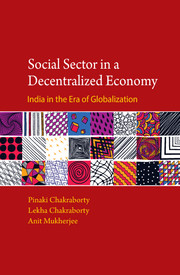Book contents
- Frontmatter
- Contents
- List of Tables, Figures, Boxes and Appendices
- List of Abbreviations
- Preface
- 1 Unpacking Decentralization
- 2 Decentralization in Service Delivery: Empirical Evidences
- 3 Decentralization in India: History, Laws and Politics
- 4 Local-level Fiscal Decentralization: State Finance Commissions and Devolution
- 5 Decentralization of Education
- 6 Decentralization in Health Service Delivery
- 7 Measuring Benefit Incidence: Health and Education
- 8 Effectiveness of Decentralization on Service Delivery: Accountability and Efficiency
- 9 What We Have Learnt and the Way Ahead
- Bibliography
- Index
5 - Decentralization of Education
Published online by Cambridge University Press: 26 September 2017
- Frontmatter
- Contents
- List of Tables, Figures, Boxes and Appendices
- List of Abbreviations
- Preface
- 1 Unpacking Decentralization
- 2 Decentralization in Service Delivery: Empirical Evidences
- 3 Decentralization in India: History, Laws and Politics
- 4 Local-level Fiscal Decentralization: State Finance Commissions and Devolution
- 5 Decentralization of Education
- 6 Decentralization in Health Service Delivery
- 7 Measuring Benefit Incidence: Health and Education
- 8 Effectiveness of Decentralization on Service Delivery: Accountability and Efficiency
- 9 What We Have Learnt and the Way Ahead
- Bibliography
- Index
Summary
Education system in India in the post-independence years was heavily influenced by the colonial legacy. The British had imposed on the existing Indian education system centralized control by the colonial administrator. The system of centralized official control eroded teacher's autonomy by denying her any initiative in matters pertaining to curriculum, whereas earlier teachers mostly went by conventions, but they had the freedom to make choices. Norohna (2003) talks about the spontaneous community involvement in education in school systems in the nineteenth century Bihar and Bengal, before British influence extended to the interiors, instances of schools that were collaborative ventures between teachers and community.
The system of education expanded enormously since independence. It was, however, not able to shed colonial policies of prescriptions of textbooks and examinations, bureaucratization and centralized management (Kumar, 1992). Rather the tendencies were strengthened in a drive towards universalization of education. From the 1950s and 1960s, the government(s) affected a takeover of the educational establishments as well as of the cadre of teachers. Teachers were now recruited from across the state, instead locally. Teacher's post was made transferable. This marked the beginning of professionalization on the one hand and distrust of teachers on the other.
While the process of universalization was painfully slow in its progress (Table 5.1, the decadal literacy rates in India), almost unnoticed the education system became divided into two subsystems: the common and the exclusive. The first subsystem consists of children who depend on the state for school education, and second of those whose education is paid for by the parents. Private schools professed a ‘quality’ advantage and carried assurances for upward socio-economic mobility so that parents, not only the elite, overextended themselves to gain admission to these institutions.
The educational reforms in India have, thus, to be understood against the background of a centralized bureaucratically controlled and managed public education system that still excluded vast masses of children at the bottom (the out-of-school and the drop-out children), at the same time that it was faced with rising competition from the private schools that offered ‘better quality’, effective accountability and greater choices to parents.
- Type
- Chapter
- Information
- Social Sector in a Decentralized EconomyIndia in the Era of Globalization, pp. 80 - 105Publisher: Cambridge University PressPrint publication year: 2016
- Creative Commons
- This content is Open Access and distributed under the terms of the Creative Commons Attribution licence CC-BY-NC-ND 3.0 IGO https://creativecommons.org/cclicenses/



